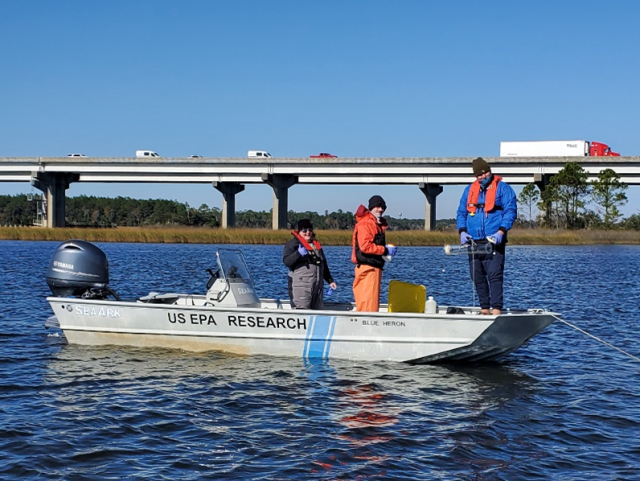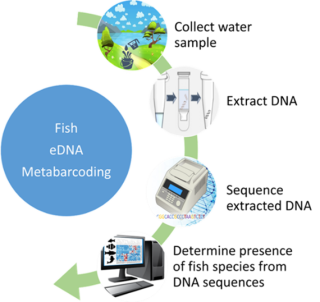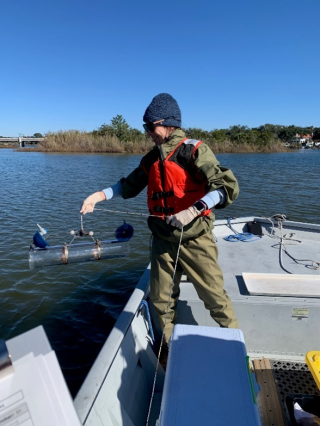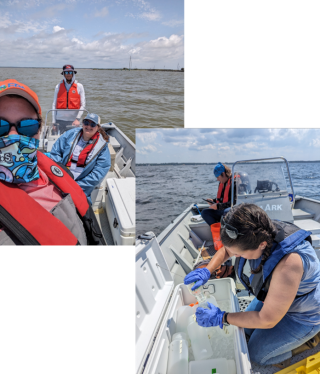How EPA Scientists Use Fish eDNA to Assess Estuarine Health
Published August 20, 2024

Estuaries are waterbodies where freshwater from the uplands mixes with the salty waters of the open ocean. The bays, inlets and tidal rivers along a coastline that comprise estuarine systems are important to wildlife and humans alike. Estuaries provide habitat for fish and wildlife, protect coastal shorelines, and contribute to local and national economies. While millions of people visit estuaries every year to experience their natural beauty and biological diversity, these unique ecosystems define an entire way of life for coastal communities.
The resilience of estuaries is under constant pressure from the land (e.g., development, pollution) and the sea (e.g., sea level rise, hurricanes). Many coastal states heavily invest in the preservation and restoration of estuarine habitats such as oyster reefs, seagrasses and coastal wetlands. One way to measure the effectiveness of these efforts to protect or improve estuarine condition is to survey fish populations. The existence of a wide variety of native fish species is one indicator of good estuarine condition. However, traditional methods of fish sampling — which involve catching, counting, measuring, and other testing of organisms — are often environmentally invasive, expensive and limited to specific types of fish like invasive species.

“In the region, there is a strong relationship between the ecological condition of estuaries and the health and well-being of coastal communities,” EPA social scientist Linda Harwell noted.
In 2022, EPA researchers launched a pilot study using environmental DNA (eDNA) sampling as a modern approach for collecting basic fish community information. Living organisms constantly shed DNA into their surrounding environment, and this genetic material can be used to more precisely identify organisms that live in, or periodically visit, different aquatic habitats. This DNA material can be readily obtained from water, sediment, and other environmental samples with minimal disturbance to fish or other wildlife. eDNA techniques are promising as a more efficient way to examine the distribution of biological communities in a natural setting. The purpose of the research was to see if fish eDNA sampling methods could be applied as a monitoring approach to assess change in fish communities in estuarine habitats undergoing restoration.
“Locals are very involved with water activities and they value a healthy ecosystem. Our team wants to make sure these communities are not only informed, but are given access to clean, safe, and thriving coastal habitats,” EPA biologist Lenny Cheskiewicz said. “Fish eDNA testing is one way to do that without relying solely on methods such as line and hook sampling, which can be ecologically destructive and overly dependent on external factors like season and weather.”

From fall 2022 through spring 2023, EPA scientists collected water samples at 25 locations randomly placed in habitat restoration areas distributed across the Pensacola and Perdido Bays estuaries, located on the Alabama-Florida state border. Targeted habitats included oyster reefs, seagrass beds, saltmarsh edge and living shorelines. EPA researchers extracted DNA material from 100 water samples and are currently analyzing DNA sequence data to identify the genetic “fingerprints” that can be used to identify likely fish species that visit or take refuge in local estuarine habitats. The researchers hope that the fish eDNA sampling strategy will produce results that can help Gulf estuarine resource managers monitor improvement in their coastal restoration efforts and assess the suitability of local waters to support thriving fish populations.
Launching in New Waters
At present, the EPA fish eDNA team is continuing their research in new locations that include five estuarine systems spanning 186 miles, from Mobile, Alabama, to Apalachicola, Florida. Working with researchers from the Mobile Bay National Estuary, Pensacola and Perdido Bays Estuary Program, Choctawhatchee Bay Estuary Program, St. Andrew and St. Joe Bays Estuary Program, and Florida Fish and Wildlife Institute, EPA scientists are evaluating the transferability of the methods tested in the original pilot study. New eDNA samples collected at 42 sites taken in April, June and August will be analyzed to evaluate the comparability of results collected in different estuarine systems and with different sampling crews. Similar to the original study, sampling locations were placed randomly across different habitat types in various stages of restoration.

“We hope that in the coming years our research partners can use these fish eDNA techniques on their own to complement their existing fish and restoration monitoring programs,” Harwell said.
Meet the Crew
The estuarine fish eDNA team includes a core group of EPA scientists: Alejandro “Alex” Almario (biologist), Leonard “Lenny” Cheskiewicz (biologist), Adam Glahn (biologist), Linda Harwell (social scientist), Erin Reschke (biologist), Rosmin “Rossie” Ennis (biologist), and Lisa Smith (biologist). The research team represents a variety of research disciplines, from coastal ecology and biology to social science. Everyone contributes to the strategic planning and implementation of the fish eDNA pilot study series, offering expertise and insight to inform sampling design, field logistics, geospatial processing, data analysis, and community and partner engagement.
All in a Day’s Work
The eDNA sampling cycles last for two weeks and occur in different seasons. During sampling events, EPA vessels navigate to preselected sampling locations which can take a few minutes to a few hours to reach. The scientists aboard each boat collect data about various conditions while on a site which includes observations of visible trash and other stress-related conditions. Water column measurements are taken, such as water depth, salinity, and clarity, using tools like a secchi disk and hydrographic profiler. Water samples are collected using a Van Dorn water sampler, then kept in a cooler until the end of the sampling day. Much care is taken to ensure that samples are not contaminated from one sampling site to another. This entails sanitizing all areas of the boat and equipment between locations. At the end of the day, collected samples are returned to the lab to be filtered, frozen and sent off for DNA sequencing.

EPA scientists, Erin Reschke (foreground) and Adam Glahn (top), take Blair Morrison, Mobile Bay National Estuary Program (center), out for a day of sampling.
Right photo:
Melinda Gates (Choctawhatchee Bay Estuary Program) takes a field control sample to accompany the day’s water sample collection.
A day on the water is not always glamorous. The team is diligent about ensuring the safety of the crew and that time spent in the field is time well spent. Open water sampling on a boat can expose researchers to a variety of weather and environmental conditions. On even the hottest days, the field team wears personal protective equipment, like all-weather clothing, hats, eye protection, gloves and life jackets. These precautions not only ensure that data are not skewed by DNA transfer but also help safeguard the team from unknown hazards.
During sampling events, the fish eDNA team has opportunities to interact with members of the community such as fisherman. These interactions are integral to the long-term success of the project.
“When we speak with people on the boat ramps, they want to know what we’re testing for and it is important that the community knows what we’re doing and why,” EPA biologist Alex Almario said. “It is interesting to hear about how locals have noticed the environment changing over the years, so we hope to give them data that will show what changes have occurred and why.”
“We want the community to know that we are there to help preserve the very things that are important to them,” Harwell echoed. “The ecological conditions that we’re researching impact everyday life, and we owe it to these communities to continually improve the ways we assess coastal environments.”
Navigating Future Fish eDNA Efforts
The eDNA team hopes to continue sampling along the Gulf coast and using their findings to assess biodiversity to help quantify the success of coastal restoration efforts. The EPA researchers hope that continuing this work will further develop the case for using fish eDNA sampling for widespread use in estuarine systems. With results from past sampling efforts already proving useful, the team is optimistic that their project will inspire similar sampling techniques in estuaries across the U.S.
This article was written by Sarah Whichello, Oak Ridge Associated Universities Research Participant with EPA.
